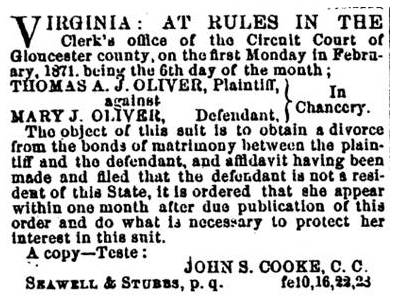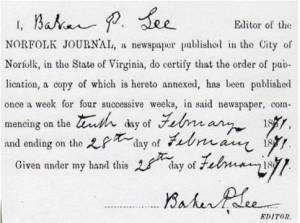Thomas Andrew Jackson Oliver
1833-1917
Elizabeth Lewis Riley
1864-1938
Thomas Andrew Jackson (Jack) Oliver was born on January 1, 1833, at Hickory Fork, Gloucester. According to his daughter, Rebecca, he was raised on the Oliver property at the headwaters of Cedar Bush Creek. It seems that Jack Oliver’s early childhood was lived in a stable family environment; however, after his father’s untimely death when Jack was about six years old, life was not as harmonious. His mother’s second marriage did not improve the situation.
Jack Oliver had an older brother, Washington, and two half brothers, Benjamin and James. Apparently, Jack was raised in a family composed of four sons, a loving mother, and a stepfather who was not always in a harmonious relation with the rest of the family.
Jack Oliver listed his occupation as “laborer” on the 1860 census, as “sailor” on the 1870 census, and as “oysterman” on the 1900 census. Although each of these occupations is different, they all seem to be related to the oyster industry. In fact, his entire life seemed to be related to oysters. His occupation as a sailor probably was the transporting of oysters from Gloucester to Baltimore on a sailboat. Later, he operated a country store on Cedar Bush Creek which most likely was an outgrowth of the oyster business. He also owned a sizable amount of real estate. The 1870 census seems to confirm Jack’s combined sailor-oysterman-farmer livelihood; his occupation is listed as “sailor,” but the occupations of his two half brothers, living in his household, are listed as “oysterman” and “farmer.” This census also listed his personal property value at $1600 and his real estate valued at $1500. In the mid 1800’s, this would be considered substantial holdings; for example, the real estate valued at $1500 was actually 82 acres of waterfront property with a residence and other farm buildings.
On July 29, 1861, T. A. J. Oliver enlisted in Company D of the 21st Regiment of the Virginia Militia at Ware Point, Gloucester County, Virginia. After serving 19 days as a private, he was promoted to sergeant in which capacity he served 35 days. On October 19, 1861, he transferred to Company C at Gloucester Courthouse and was stationed at Gloucester Point. The Company Muster Roll dated Feb. 28, 1862, stated that Jack Oliver was “absent sick with leave.” The May 12, 1862, muster roll stated that he “deserted on the march from Glo. Point.”
T. A. J. Oliver’s Civil War Records
In the early stages of the Civil War, some soldiers were motivated to enlist because they understood their armed service as defending their homes. When called to serve in a larger war effort, they simply returned home and were considered deserters. Jack Oliver’s daughter, Edith, recalled that a neighbor referred to her father as a “damn deserter.” Whatever the situation, these were “times that try men’s souls.”
It is not known when Jack Oliver began the business of transporting oysters to Baltimore; however, it must have been as early as 1864 because he stated that he was in Baltimore at that date. [One wonders how it was possible for him to maintain commerce between Gloucester and Baltimore during the Civil War; some Civil War buffs say that such commerce was not uncommon.]
On one of Oliver’s 1864 trips to Baltimore, he met a 14 or 15 year old girl, Mary Isabella Lewis. He must have maintained these trips to Baltimore for several years because he said, “I had been acquainted with her [Isabella Lewis] for about three years but I had not seen her for twelve months when I went to Baltimore to be married.” On June 11, 1867, Jack Oliver, age 34, married Isabella Lewis, age 17 in Baltimore. The June 13,1867, issue of the Baltimore Sun had the following item in the marriage announcements:
Oliver-Lewis at the residence of the bride by Rev. John Berg, on 11 June, Thomas A. J. Oliver of Gloucester County, Va.
to Mary I., youngest daughter of the late John Lewis, Esq. Baltimore. (Richmond & New York papers please copy.)
On June 13, 1867, Jack returned to Gloucester with his bride and lived in the Clay Bank area. For Jack Oliver, the marriage to Isabella proved to be another one of those “times that try men’s souls.” Within three weeks, Isabella publicly stated that she wanted a divorce and spat in Jack’s face. Jack “was mortified by the discovery that his wife was not satisfied with her home in the county, preferring to reside in the City of Baltimore.”
Not long after the spitting-in-the-face incident, Isabella left Jack’s home and spent the night in the home of Carter Williams. The following morning, Jack went to the Williams home and pleaded with her to return to his home. She complied with his wishes, but during the next several months she was very “quarrelsome,” at times refusing to eat meals at the family table. On these occasions, Jack would take her meals to her room before he ate his meals. During this time, Jack solicited the service of the local Baptist minister, Mr. Hawkins, to counsel with Isabella, but Mr. Hawkins efforts were to no avail.
Isabella returned to Baltimore for a visit from December 10, 1867, to January 19, 1868. Isabella gave birth to a son, James Thomas Oliver, on April 5, 1868; this child died on May 5, 1868. After the death of her child, Isabella’s disposition became worse. She left Jack’s home and stayed with neighbors for about a week; then in August, she returned to Baltimore vowing never to return. However, she did return to Jack’s home on May 13, 1869, bringing with her a daughter, Annie Bell Oliver, born on April 5, 1869, in Baltimore.
Isabella said that had it not been for the child, she would not have returned to Gloucester; when the child died on June 3, 1869, she expressed her intent to return to Baltimore. Jack pleaded with her not to go; he refused to pay for her passage but offered her shares of his property holding if she would stay. She vowed to leave and told Jack that if he followed her she would “have him shot.” On August 14, 1869, Jack went to Yorktown on business, and in his absence Isabella left for Baltimore.
Isabella had a sister, Mrs. Cliff, who rented two rooms from a Mrs. Elizabeth Ann Horney at 59 Hampstead Street, Baltimore, Maryland. Mrs. Horney observed Isabella in compromising situations on several occasions. Once, Mrs. Horney and the wife of Isabella’s lover confronted them in an adulterous affair; Mrs. Horney said that Isabella “laughed.” Eventually, Mrs. Horney would not allow Isabella to visit her sister, Mrs. Cliff, in her home. Through his associates in Baltimore, Jack was informed of the manner of life his wife was living and decided to file for a divorce. The following ad ran in a Norfolk newspaper:
In April, 1871, the Circuit Court of Gloucester County, Virginia, decreed “That the marriage between Thomas A. J. Oliver and Mary Isabella Oliver be and the same is hereby dissolved, the said Thomas A. J. Oliver forever divorced from his said wife, Mary Isabella Oliver and all the rights, title and interest of the said Mary Isabella in and to the estate real and personal of the said Thomas A. J. Oliver shall henceforth cease.” The judge added this final sentence to the divorce decree: “Neither the plaintiff or the defendant shall again marry without the approbation and leave of this Court and leave is reserved to each party to apply for such leave at any future time.” Jack Oliver did apply for this waver (“leave”) which was granted at a later date.
On April 2, 1866, Jack Oliver bought 83 acres of land located at the end of Cedar Bush Road. This land formed a peninsula bound on one side by Cedar Bush Creek and on the other side by Brigg’s Cove. There is a discrepancy in the number of acres on the deed and the acreage on the surveyor plot; Jack Oliver, at various times, had other landholdings in the Coke area and in Clay Bank.
Parts of this real estate were sold to Jack’s brother, James, and other members of the family. The primary use of the land was farming; more significantly, this land later became the site of the Oliver “homeplace” with a country store located in the yard.
Many of Jack Oliver’s children told stories about the existence of the country store and how its day-to-day operations took place. These stories were verified by the discovery of a ledger that recorded transactions in the store with entries from 1881 to 1902. This writer wrote an article in Glo-Quips about Jack Oliver’s store; it is quoted as follows with slight editing:







You have a great collection of pictures and documents…many brought back great memories and many were of people I knew when they weremuch older. I always remember A’Beck with a twinkle in her eye and a wonderful smile.
So glad you enjoyed the pictures and stories about Rebecca’s family … I hope you’ll share our history with other family members.
This is my family heritage and homestead to this day. Oliver landing is at the end of cedar bush creek as a public landing now. My grandfather was Lawrence Puller Oliver. My great great grandfather was Thomas Andrew Jackson Oliver in this story!